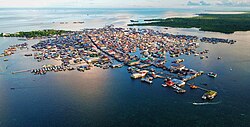Top Qs
Timeline
Chat
Perspective
Sitangkai
Municipality in Tawi-Tawi, Philippines From Wikipedia, the free encyclopedia
Remove ads
Sitangkai, officially the Municipality of Sitangkai (Tagalog: Bayan ng Sitangkai), is a municipality in the province of Tawi-Tawi, Philippines. According to the 2020 census, it has a population of 37,319 people.[5]
It is the southernmost place in the Philippines and is very close to Malaysia and Indonesia.
It is called the "Venice of the South"[6] due to the use of boats as primary transportation, although footbridges connect one house to another. The major sources of livelihood are fishing and farming, although there is very sparse agricultural land available.
This town is the southernmost town in the whole archipelago, and this town is the southernmost town in the province of Tawi-Tawi.
The Frances Reef located in the town of Sitangkai is geographically the southernmost point of the Philippines.
Remove ads
History
Summarize
Perspective


The historical Sitangkai group of islands comprises the islands, areas, and barangays of the present Sitangkai and Sibutu municipalities. The islands had been at the crossroads of the sea trade route and were a traditional enclave of the Bajau and Sama people who for centuries had peacefully lived off fishing and trading. The Kadatuan of Sitangkai and Sibutu were descended from the royalties of Sulu, Sabah, and Sarawak. Historical personalities such as the Datu Iskandar of Sibutu and the Datu Halon of Sitangkai was descended from the Datu Baginda Putih, Datu Baginda Hitam, and the feared Datu Kurunding of Lahat Datu from Borneo (now part of the Malaysian and Indonesian states). In the early 1900s, a man named Lailuddin ibn Jalaluddin from the area of Nunukan, Parang, Sulu was noted to be the first Tausūg to settle in Sitangkai, bringing with him his clan, wealth, and slaves. Together with his sons and nephews, they settled, intermarried, and made alliances with the local traditional leaders and inhabitants. During World War II, Sitangkai and Sibutu, being closer to British Borneo, was targeted by patrols and occasional raids by Japanese Imperial soldiers. Sitangkai nowadays is still a jump off port for traditional traders from Sulu, Zamboanga, mainland Tawi-Tawi going to Sabah and Borneo.
Twenty municipal districts of the then-undivided Sulu, including Sitangkai, were converted into municipalities effective "as of July 1, 1958", by virtue of Executive Order No. 355 issued by President Carlos P. Garcia on August 26, 1959.[8] On October 21, 2006, with the ratification of Muslim Mindanao Autonomy Act No. 197, 16 of its 25 barangays were transferred to the newly created municipality of Sibutu, all of which were located on Sibutu Island.
Remove ads
Geography
Barangays
Sitangkai is politically subdivided into 9 barangays. Each barangay consists of puroks while some have sitios.
- Datu Baguinda Putih
- Imam Sapie
- North Larap
- Panglima Alari
- Sipangkot
- Sitangkai Poblacion
- South Larap (Larap)
- Tongmageng
- Tongusong
Climate
Sitangkai has a tropical rainforest climate (Af) with heavy rainfall year-round.
Remove ads
Demographics
Economy
Sitangkai is often referred to as the "Venice of the South" with boats being the primary mode of transportation within the town. Its location as the southernmost town in the Philippines makes the town as a trading port for transporting goods to and from neighboring Malaysia.[15]
Poverty Incidence of Sitangkai
10
20
30
40
50
60
2006
36.60 2009
31.68 2012
23.79 2015
28.85 2018
24.03 2021
57.62 Source: Philippine Statistics Authority[16][17][18][19][20][21][22][23] |
Remove ads
Healthcare
As of 2021, there is no hospital in Sitangkai.[15]
References
External links
Wikiwand - on
Seamless Wikipedia browsing. On steroids.
Remove ads





